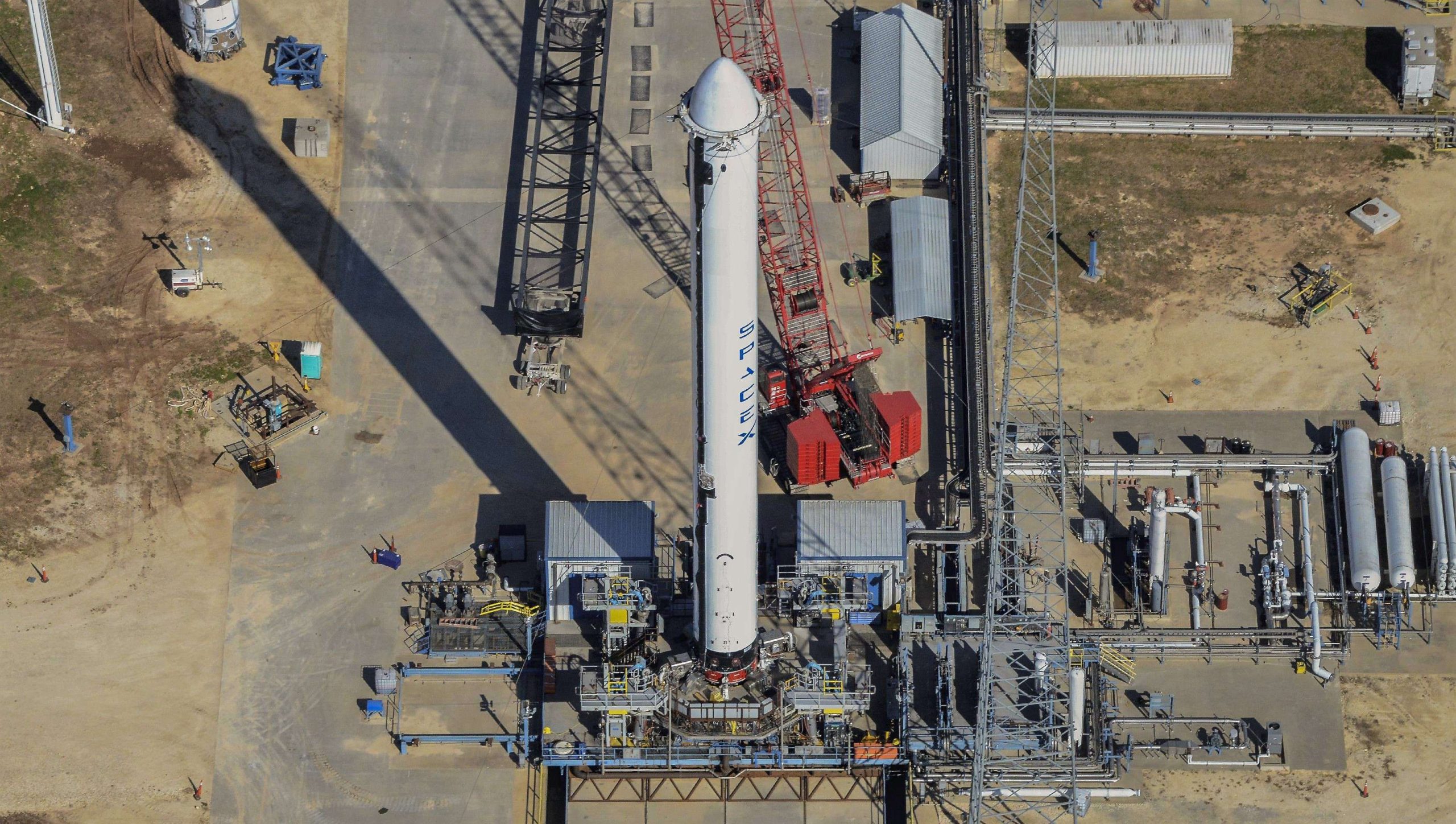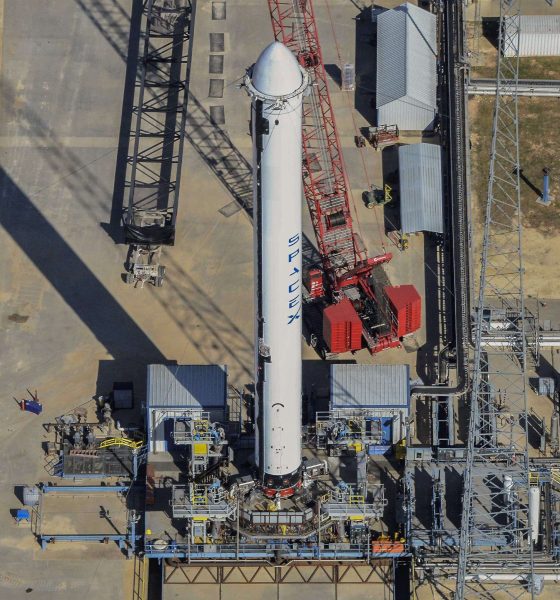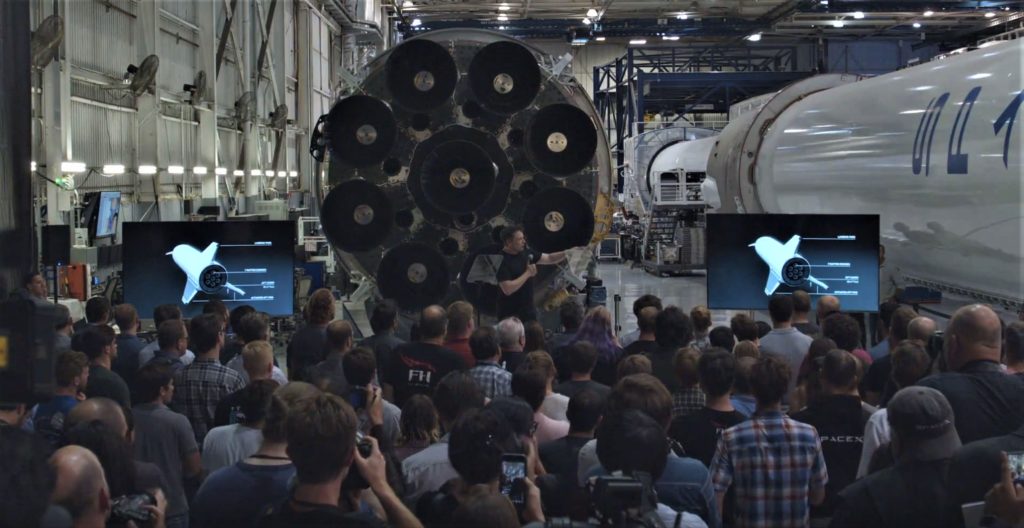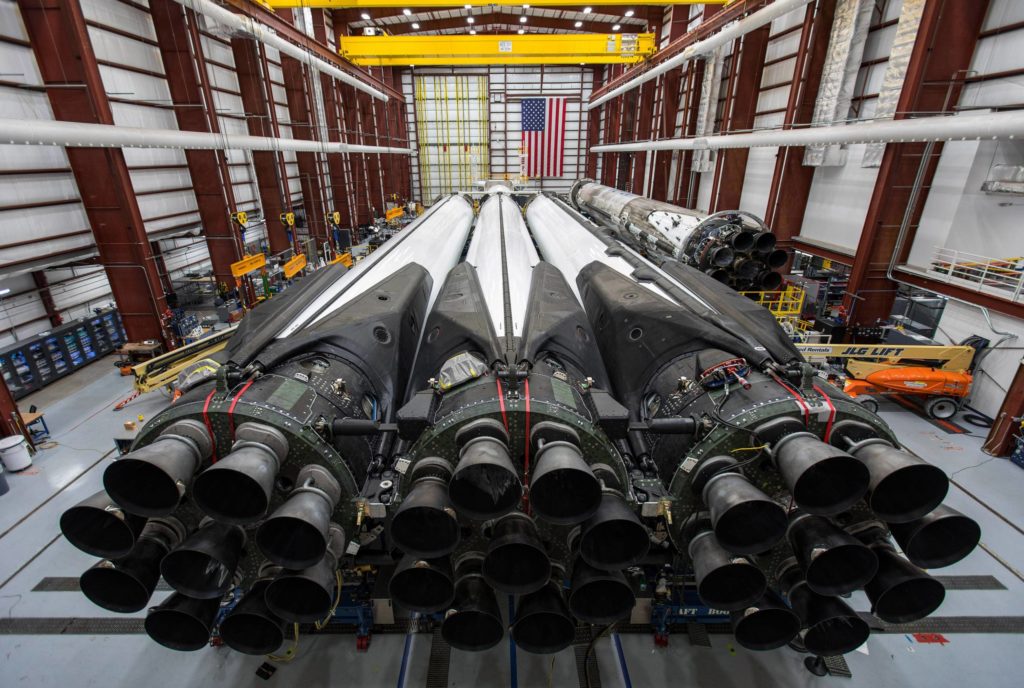

News
SpaceX Falcon Heavy side booster arrives at Texas test facilities
NASASpaceflight.com reports that the first new booster for SpaceX’s next Falcon Heavy launch has arrived at the company’s McGregor, Texas test facilities.
The canonical sign that SpaceX is rapidly progressing towards its next Falcon Heavy launch, the mission – set to carry the US military’s US Space Force 44 (USSF-44) satellite(s) directly to geostationary orbit (GEO) – requires all new boosters. For SpaceX, barring a major surprise in the next five months, USSF-44 will be the first operational direct-to-GEO launch in the company’s history – a milestone years and multiple test flights in the making.
US military officials have begun to at least vaguely support the idea of flying payloads on flight-proven SpaceX rockets but it looks to be a long uphill battle ahead of the company. It took almost half a decade and four-dozen successful booster landings for the US Air Force to even allow SpaceX to attempt to land a Falcon 9 booster after an operational military launch. As a result, the company will likely be building new rockets for its military launches for the indefinite future – Falcon Heavy and its three boosters included.
The photo at the top of this article shows a largely identical Falcon Heavy Block 5 side booster – either B1052 or B1053 – during a late-2018 static fire acceptance test campaign in McGregor, Texas.
Based on NASASpaceflight.com’s aerial photos of the latest rocket to arrive in McGregor, Texas, one would assume that SpaceX was simply testing a new Falcon 9 first stage. Notably, the booster appears to have a Falcon 9 interstage installed, whereas Falcon Heavy side boosters have historically been tested with nosecones installed. However, by analyzing the layout of decals visible on its exterior, author Thomas Burghardt discovered that the booster – believed to be B1064 – is likely the first of two new Falcon Heavy side boosters needed for USSF-44.
For unknown reasons, SpaceX has outfitted, transported, and prepared B1064 for acceptance testing with a years-old interstage installed, effectively making it a Falcon Heavy side booster in Falcon 9 clothing (sans nosecone).

In its current configuration, the process of manufacturing three new Falcon Heavy boosters at SpaceX’s Hawthorne, CA factory takes at least half a year from the start of tank welding to shipment. After each booster is completed, it must ship to McGregor, Texas for at least 4-6 weeks to undergo acceptance tests, including at least one wet dress rehearsal (WDR) and static fire. In other words, if the first of three new Falcon Heavy Block 5 boosters has just arrived in McGregor, SpaceX likely has two or three months of work to go before the entire USSF-44 rocket is on site at Florida’s Kennedy Space Center.
Just two weeks ago, a US military official revealed that SpaceX’s USSF-44 Falcon Heavy launch date had slipped from late-2020 (likely November or December) to no earlier than (NET) February 28th, 2021. The cause of the delay is unknown but either way, it should give SpaceX two full months to process Falcon Heavy Flight 4 hardware in Florida (or several weeks of margin wherever needed). After USSF-44, SpaceX’s next Falcon Heavy launch – USSF-52; also expected to fly on all-new boosters – was scheduled to launch NET “early 2021” before the preceding mission’s delay was announced. To achieve that schedule, SpaceX will likely be building and testing new Falcon Heavy boosters – and Falcon Heavy boosters only – from mid-2020 to at least Q1 2021.

On the plus side, as NASASpaceflight.com noted, if SpaceX manages to recover all USSF-44 and USSF-52 boosters, it will quickly find itself with a fleet of six side boosters and two center cores.
Check out Teslarati’s Marketplace! We offer Tesla accessories, including for the Tesla Cybertruck and Tesla Model 3.

News
Tesla is seeing a lot of momentum from young Koreans in their 20s-30s: report
From January to November, young buyers purchased over 21,000 Teslas, putting it far ahead of fellow imported rivals like BMW and Mercedes-Benz.

Tesla has captured the hearts of South Korea’s 20s-30s demographic, emerging as the group’s top-selling imported car brand in 2025. From January to November, young buyers purchased over 21,000 Teslas, putting it far ahead of fellow imported rivals like BMW and Mercedes-Benz.
Industry experts cited by The Economist attributed this “Tesla frenzy” to fandom culture, where buyers prioritize the brand over traditional car attributes, similar to snapping up the latest iPhone.
Model Y dominates among young buyers
Data from the Korea Imported Automobile Association showed that Tesla sold 21,757 vehicles to the 20s-30s demographic through November, compared to BMW’s 13,666 and Mercedes-Benz’s 6,983. The Model Y led the list overwhelmingly, with variants like the standard and Long Range models topping purchases for both young men and women.
Young men bought around 16,000 Teslas, mostly Model Y (over 15,000 units), followed by Model 3. Young women followed a similar pattern, favoring Model Y (3,888 units) and Model 3 (1,083 units). The Cybertruck saw minimal sales in this group.
The Model Y’s appeal lies in its family-friendly SUV design, 400-500 km range, quick acceleration, and spacious cargo, which is ideal for commuting and leisure. The Model 3, on the other hand, serves as an accessible entry point with lower pricing, which is valuable considering the country’s EV subsidies.
The Tesla boom
Experts described Tesla’s popularity as “fandom culture,” where young buyers embrace the brand despite criticisms from skeptics. Professor Lee Ho-geun called Tesla a “typical early adopter brand,” comparing purchases to iPhones.
Professor Kim Pil-soo noted that young people view Tesla more as a gadget than a car, and they are likely drawn by marketing, subsidies, and perceived value. They also tend to overlook news of numerous recalls, which are mostly over-the-air software updates, and controversies tied to the company.
Tesla’s position as Korea’s top import for 2025 seems secured. As noted by the publication, Tesla’s December sales figures have not been reported yet, but market analysts have suggested that Tesla has all but secured the top spot among the country’s imported cars this year.
News
Tesla FSD fleet is nearing 7 billion total miles, including 2.5 billion city miles
As can be seen on Tesla’s official FSD webpage, vehicles equipped with the system have now navigated over 6.99 billion miles.

Tesla’s Full Self-Driving (Supervised) fleet is closing in on almost 7 billion total miles driven, as per data posted by the company on its official FSD webpage.
These figures hint at the massive scale of data fueling Tesla’s rapid FSD improvements, which have been quite notable as of late.
FSD mileage milestones
As can be seen on Tesla’s official FSD webpage, vehicles equipped with the system have now navigated over 6.99 billion miles. Tesla owner and avid FSD tester Whole Mars Catalog also shared a screenshot indicating that from the nearly 7 billion miles traveled by the FSD fleet, more than 2.5 billion miles were driven inside cities.
City miles are particularly valuable for complex urban scenarios like unprotected turns, pedestrian interactions, and traffic lights. This is also the difference-maker for FSD, as only complex solutions, such as Waymo’s self-driving taxis, operate similarly on inner-city streets. And even then, incidents such as the San Francisco blackouts have proven challenging for sensor-rich vehicles like Waymos.
Tesla’s data edge
Tesla has a number of advantages in the autonomous vehicle sector, one of which is the size of its fleet and the number of vehicles training FSD on real-world roads. Tesla’s nearly 7 billion FSD miles then allow the company to roll out updates that make its vehicles behave like they are being driven by experienced drivers, even if they are operating on their own.
So notable are Tesla’s improvements to FSD that NVIDIA Director of Robotics Jim Fan, after experiencing FSD v14, noted that the system is the first AI that passes what he described as a “Physical Turing Test.”
“Despite knowing exactly how robot learning works, I still find it magical watching the steering wheel turn by itself. First it feels surreal, next it becomes routine. Then, like the smartphone, taking it away actively hurts. This is how humanity gets rewired and glued to god-like technologies,” Fan wrote in a post on X.
News
Tesla starts showing how FSD will change lives in Europe
Local officials tested the system on narrow country roads and were impressed by FSD’s smooth, human-like driving, with some calling the service a game-changer for everyday life in areas that are far from urban centers.

Tesla has launched Europe’s first public shuttle service using Full Self-Driving (Supervised) in the rural Eifelkreis Bitburg-Prüm region of Germany, demonstrating how the technology can restore independence and mobility for people who struggle with limited transport options.
Local officials tested the system on narrow country roads and were impressed by FSD’s smooth, human-like driving, with some calling the service a game-changer for everyday life in areas that are far from urban centers.
Officials see real impact on rural residents
Arzfeld Mayor Johannes Kuhl and District Administrator Andreas Kruppert personally tested the Tesla shuttle service. This allowed them to see just how well FSD navigated winding lanes and rural roads confidently. Kruppert said, “Autonomous driving sounds like science fiction to many, but we simply see here that it works totally well in rural regions too.” Kuhl, for his part, also noted that FSD “feels like a very experienced driver.”
The pilot complements the area’s “Citizen Bus” program, which provides on-demand rides for elderly residents who can no longer drive themselves. Tesla Europe shared a video of a demonstration of the service, highlighting how FSD gives people their freedom back, even in places where public transport is not as prevalent.
What the Ministry for Economic Affairs and Transport says
Rhineland-Palatinate’s Minister Daniela Schmitt supported the project, praising the collaboration that made this “first of its kind in Europe” possible. As per the ministry, the rural rollout for the service shows FSD’s potential beyond major cities, and it delivers tangible benefits like grocery runs, doctor visits, and social connections for isolated residents.
“Reliable and flexible mobility is especially vital in rural areas. With the launch of a shuttle service using self-driving vehicles (FSD supervised) by Tesla in the Eifelkreis Bitburg-Prüm, an innovative pilot project is now getting underway that complements local community bus services. It is the first project of its kind in Europe.
“The result is a real gain for rural mobility: greater accessibility, more flexibility and tangible benefits for everyday life. A strong signal for innovation, cooperation and future-oriented mobility beyond urban centers,” the ministry wrote in a LinkedIn post.








